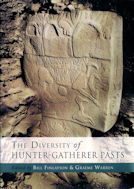This thought provoking collection of new
research papers explores the extent of variation
amongst hunting and gathering peoples past and present
and the considerable analytical challenges presented by this diversity.
This problem is especially important in archaeology,
where increasing empirical evidence illustrates ways of life
that are not easily encompassed within the range of variation
recognised in the contemporary world of surviving hunter-gatherers.
Put simply, how do past hunter-gatherers fit into our understandings of hunter-gatherers?
Furthermore, given the inevitable archaeological reliance on analogy,
it is important to ask whether conceptions of hunter-gatherers based on contemporary societies
restrict our comprehension of past diversity and of how this changes over the long term.
Discussion of hunter-gatherers shows them to be varied and flexible,
but modelling of contemporary hunter-gatherers has not only reduced them into essential categories,
but has also portrayed them as static and without history.
It is often said that the study of hunter-gatherers
can provide insight into past forms of social organisation and behaviour;
unfortunately too often it has limited our understandings of these societies.
In contrast, contributors here explore past hunter-gatherer diversity
over time and space to provide critical perspectives on general models
of ‘hunter-gatherers’ and attempt to provide new perspectives on hunter-gatherer societies
from the greater diversity present in the past.
